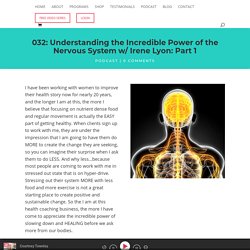

Ten things you need to know when healing early trauma - Irene Lyon. In this week’s video I cover the basics of what I believe folks should be aware of when healing early traumatic wounds.

This might be one of the tougher topics to write and video about because each person is unique and how one heals the wounds of early trauma are dependent on SO many factors. It looks different for each person. That’s why it’s key we follow practices and healing approaches that follow principles, rather than step-by-step methods. Here’s an outline of the ten main things that I cover (but in greater depth) in this video: Healing at this level is not about shaking it out (it’s about regulation).
I want to open up this conversation because as a whole, the bulk of my clients and students are living with some form of untreated early trauma and it often goes undiagnosed, or is treated with methods designed for shock trauma. Early trauma usually bubbles up later in life, although sometimes it can start in childhood or adolescence. This all sounds rather depressing, doesn’t it? Restoring Resilience & Healthy Sexuality - Ariel Giaretto. We are born embodied and sensual before parents, culture, religion, peers, intergenerational beliefs and trauma begin to skew our connection to our most essential selves and, consequently, to others.

This conditioning undermines our ability to accept our bodies, to identify or keep dependable partners, to surrender to our inherent sensuality and to receive healthy, genuine love when it presents itself. This interactive webinar explores how this happens through the lens of the Somatic Experiencing® trauma model. It offers a variety of simple somatic exercises designed to leave old traumas and beliefs behind so that we can welcome new levels of pleasure and connection. Irene Lyon Neurosensory Exercises. Online Neuroscience Courses.
How to Think More Positively When You’re In Pain. You may know that negative thinking is hard on your body and contributes to pain and illness.

You may even have a doctor or other health care provider who recommends that you “reduce stress” and try to think more positively in order to heal your body. If so, and you’ve tried to think more positively, you probably also know that this is much easier said than done! Nothing triggers stressful, negative, fearful thinking like pain and illness. Podcast: Understanding the Incredible Power of the Nervous System w/ Irene Lyon: Part 1.
I have been working with women to improve their health story now for nearly 20 years, and the longer I am at this, the more I believe that focusing on nutrient dense food and regular movement is actually the EASY part of getting healthy.

Trauma Care Audio Guided Meditations Designed to Help You Heal. How to harness the power of neuroplasticity. A train track metaphor. I Now Suspect the Vagus Nerve Is the Key to Well-being. Have you ever read something a million times only to one day, for no apparent reason, think “Wait, what is that?” This happened to me the other day for “the vagus nerve.” I kept coming across it in relation to deep breathing and mental calmness: “Breathing deeply,” Katie Brindle writes in her new book Yang Sheng: The Art of Chinese Self-Healing, “immediately relaxes the body because it stimulates the vagus nerve, which runs from the neck to the abdomen and is in charge of turning off the ‘fight or flight’ reflex.” Also: “Stimulating the vagus nerve,” per a recent Harvard Health blog post, “activates your relaxation response, reducing your heart rate and blood pressure.”
And: Deep breathing “turns on the vagus nerve enough that it acts as a brake on the stress response,” as an integrative medicine researcher told the Cut last year. Is It Freeze? or Depression? Behind the Scenes with Depression If you work as a therapist, doctor or body worker, you may have had clients struggling depression.

9 Key Benefits We Experience When Our Nervous System Is Regulated - Irene Lyon. Liz Koch: Over-Dominant Quads and the Psoas - 3 Ways to Gain Spine-Based Coherency. Home » Liz Koch: Over-Dominant Quads and the Psoas – 3 Ways to Gain Spine-Based Coherency Over-Dominant Quads and the Psoas The large muscular thigh comes to mind when we imagine powerful kicking, jumping, climbing and running.

Athletes, dancers and runners alike recruit this large tissue located in the front of the upper leg for power-sprung motion. But when does too much quad power become a detriment? When does putting your large quad forward become cause for achy hip sockets, low back pain, and core tension? Embryology - The Midline (1) Embryology - The Nervous System (2) Peter Levine’s Felt Sense Exercise – The Art of Healing Trauma. I read the book Waking the Tiger by Peter Levine back in 2009 and then from October 2010 until December 2011 had sessions with an excellent Somatic Experiencing therapist to address symptoms of PTSD (Somatic Experiencing is the somatic therapy developed by Peter Levine).

A central component of Somatic Experiencing is the “felt sense.” The felt sense is the embodiment (bringing awareness inside the body) of one’s ever-changing sensory/energetic/emotional landscape. The felt sense moves our focus from actions and things happening outside us in the world to qualities of our present, internal experience (e.g. textures, colors, sensations). The felt sense sounded simple when I first read about it, but as I progressed through the book I realized it is more profound than it first appeared. The felt sense is an awareness of one’s ever-changing sensations, energies and emotions as they occur in the body Instructions: Sit or lie down in a quiet location where you can comfortably focus.
Related. Trauma, Grief, Embodiment. The Holidays, Trauma, & Our Nervous Systems - Gwynn Raimondi, MA, LMFTA. Leg exercise is critical to brain and nervous system health. Groundbreaking research shows that neurological health depends as much on signals sent by the body's large, leg muscles to the brain as it does on directives from the brain to the muscles.

Published today in Frontiers in Neuroscience, the study fundamentally alters brain and nervous system medicine—giving doctors new clues as to why patients with motor neuron disease, multiple sclerosis, spinal muscular atrophy and other neurological diseases often rapidly decline when their movement becomes limited. "Our study supports the notion that people who are unable to do load-bearing exercises—such as patients who are bed-ridden, or even astronauts on extended travel—not only lose muscle mass, but their body chemistry is altered at the cellular level and even their nervous system is adversely impacted," says Dr. Raffaella Adami from the Università degli Studi di Milano, Italy. The study involved restricting mice from using their hind legs, but not their front legs, over a period of 28 days. Chill 101 - How To Activate The Parasympathetic Nervous System. Understanding the science of how the nervous system works is not only a fascinating area of study but it can be greatly beneficial to increasing your ability to consciously relax at will.

If you can relax more easily at will, then think of all the trickle down benefits that this ability will have within all areas of your life. You'll be more happy, productive, easier to get along with, and more peaceful! Sounds like a good deal. Therefore, researching and understanding how the nervous system functions is something that's worthwhile to anyone who wants to have more control over their internal state, and who wants to be able to manage the inevitable stressors that happen in day to day life, with more calm, confidence, and certainty.
A Basic Understanding Of The Autonomic Nervous System. Allowing the Senses to Recede: Relaxing the Cranial Nerves. Somatic Experiencing Orientation - Autonomic Responses. Autonomic Regulation of Sexual Function.